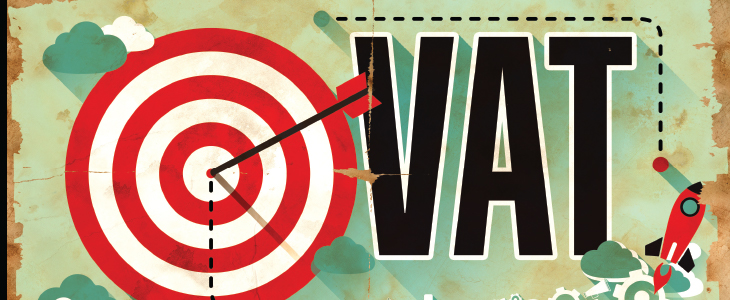
Value-added tax (VAT) is one of the most critical sources of national revenue by the majority of European state authorities, particularly in the Central and Eastern European (CEE) region. It is basically a consumption tax calculated on the value added to goods and services. It is levied on almost all commercial activities inclusive of the manufacturing and distribution of goods and the provision of services that are purchased and sold across the European Union (EU). Therefore, in order to create the environment for fair trade competition, products/services exported outside of the EU are VAT-free, whereas imported ones are subject to taxation.1
Considering the VAT’s significance to the fiscal well-being of states, declining to pay it may contribute to considerable deficiency in the delivery of public services and thwart fair market practices, because it generates higher tax obligations on honest taxpayers.2 This observation is consistent with the 2010 findings presented by Richard Murphy, a chartered accountant and a political economist, who carried out a research project at the request of Tax Justice Network. He analyzed data from the World Bank, CIA World Factbook, Heritage Foundation and the World Health Organization. He estimated that the financial revenue losses worldwide, generated as a direct consequence of tax abuses, equaled to approximately $3.1 trillion and represented 98 percent of global GDP.3 Unequivocally, VAT fraud has paramount consequences on the proper functioning not only of the global economy, but also of the EU Single Market. In accordance with the European Commission’s findings from 2013, VAT evasion affects approximately 18 percent of the total VAT base across the Union.4 Europol estimates that 40 to 60 billion euro of the yearly VAT revenue losses of EU states result from actions of organized crime groups and that 2 percent of those groups are behind 80 percent of the missing trader intracommunity fraud.5 The 2016 report on tax matters presented by PWC established that the VAT gap (i.e., the difference between the VAT, which should be collected and the actual tax revenues) oscillated between 19.1 percent in the Czech Republic to just under 40 percent in Romania. Considerable VAT gaps were also identified in Hungary (20.8 percent), Slovakia (28.3 percent) and Poland (29.2 percent). The report estimated the unremitted VAT in 2014 and 2015 amounted to 3.1 billion euros in Czech Republic, 2.6 billion euros in Hungary, 8.3 billion euros in Romania, 12 billion euros in Poland and 2.2 billion euros in Slovenia.6
VAT Charges Within the EU
Overall, VAT avoidance could take place in any transnational trade flow. Individual importers are subject to customs duties and VAT on imports at the destination border. Therefore, in instances where tariffs are not due (e.g., in the presence of a free trade agreement between states or where there is a customs union between states, such as the EU) those engaged in importing goods/services are enticed to misrepresent their trade numbers so as not to pay VAT dues.
Indeed, the EU as a single market constitutes a unique inducement for tax fraudsters due to the ease with which products and services are transferred across its borders. The current transitional VAT regime encompasses the destination principle for taxation purposes, and it is applicable to trade flows across the member states. In essence, all trade conducted within the EU borders is exempt from VAT obligations, as the importing party obtains products and services VAT-free from the exporting counterparty. Subsequently, the VAT is charged when goods are sold to customers, and the tax is then submitted to the national tax authorities. According to Katerina Gradeva, “the transitional regime breaks the VAT chain at a very vulnerable stage; all intra-EU trade flows are transported VAT-free, which leaves potential for massive VAT fraud.”7
The Ins and Outs of VAT Fraud Schemes
Tax authorities across the EU and the CEE region in particular exhibit gross inaptitude in employing effective strategies to prevent and fight VAT-related abuses. Since the EU guarantees the free movement of goods, capital, services and people, it becomes exceptionally challenging to control intra-community trade, especially in relation to the following commodities: cell phones, integrated circuits (predominantly micro-processors and chips), natural gas and electric power certificates, telecommunications services, raw metals or semi-processed elements of metals, game controls, laptops, tablets, and cereals and industrial crops.8 The selection of these particular goods is not random, as they serve well in the perpetration of one of the most ubiquitously employed VAT fraud schemes, the VAT carousel fraud, also known as missing trader intra-community VAT fraud. Through carousel fraud, perpetrators engage in the importation of goods where they do not merely underreport the adequate value of the imports, but the involved business vanishes into thin air without remitting any VAT to the national tax administration (hence, the missing trader) once the sales are concluded. In addition, VAT fraud could be conducted through various other conduits, such as, according to Gradeva, the “underreported sales (‘off the books’ sales), no firm registration to the tax authorities (‘ghost’ firms), misclassification of products in the case when a firm sells several goods taxed at different VAT rates, false claims for credit based on overstated VAT paid on inputs and imported products which are not brought into tax.”9
One of the Most Prominent Cases of the VAT Exploitation Within the EU
Operation VERTIGO began on March 3, 2015, and it is one of the most prominent cases of VAT fraud across the member states. It literally traversed the EU and was investigated by authorities from the Czech Republic, Germany, the Netherlands, and Poland, with Spain, the U.K., Belgium, Cyprus, Denmark, Ireland, Luxembourg, Gibraltar, Ukraine, Eurojust and Europol also involved. VAT evasion and illegal VAT non-reimbursements equalled more than 100 million euros in Germany, approximately 30 million euros in the Netherlands, and 10 million euros in the Czech Republic and Poland respectively. In short, the investigation started when Dutch and German officials noted a high volume of VAT returns from a number of businesses that engaged in carousel fraud practices. The joint investigation team managed to establish that certain goods and commodities were in theory forwarded to the targeted country for alleged onward consumption, but instead they were sold via numerous business establishments within the targeted country and subsequently shipped, resulting in an illegal reimbursement from tax authorities. The fraudsters utilized alternative banking platforms worldwide to, as stated by Europol, “facilitate crime-related money transfers and associated money laundering,” oscillating around several hundred million euros.10
The Way Forward at the Pan-European and the State Level Within the CEE Region
With the benefit of hindsight, these examples demonstrate the general understanding among public officials and the law enforcement community that organized criminal networks are far from ceasing their illegal activities, particularly when it comes to VAT abuses. Back in 2007, BDO Stoy Hayward, an accounting firm, observed that “Sadly, crime does often pay at the moment if you are a fraudster, which explains why large frauds are on the increase.” Although there was a clampdown on such activities, the skepticism about halting “this avalanche of huge frauds against the taxpayer” remains.11 Indeed, it seems that criminals may virtually use any commodity to engage in VAT fraud schemes, thus depriving state authorities of millions of euros. Therefore, one of the most pressing and simultaneously the most challenging issues for the EU as a whole and its individual members is the matter of tightening the VAT tax systems and introducing effective countermeasures to discourage potential criminals from engaging in VAT-related extortions.
EU’s Efforts in Combating VAT Fraud
The EU’s policy agenda has focused on the member states’ tax regimes for a couple of years. The general challenge is “a relative lack of convergence” across states, and that each country is following its own agenda to tackle tax policies, particularly VAT.12 The EU addressed the issue of tax-related crimes already in 2006 with the implementation of Council Directive 2006/112 EC on a common system of VAT. This document essentially restrained, to a certain extent, VAT extortion for scrap metal. It was subsequently amended in 2010 with the Council Directive 2010/23/EU and the Council Directive 2013/43/EU. That latest piece of EU legislation focused on tax matters by transferring the obligation to settle VAT from the supplier (as typically mandated under the EU law) to the end customer for whom the given service was performed or a commodity delivered. This changed VAT into a reverse charge mechanism, as it reversed the liability for the payment of VAT.13 The objective behind this measure is to significantly reduce, if not eliminate, carousel schemes altogether. According to the directive’s provisions, individual states will be at liberty to enforce the new directive temporarily within the following sectors: “mobile phones, integrated circuit devices, gas and electricity, telecoms services, game consoles, tablet PCs and laptops, cereals and industrial crops, and raw and semi-finished metals.”14 The directive facilitated the application of the reverse charge principle for a maximum of two years until the end of 2018.15 Alongside the reverse charge mechanism, in 2012, the EU proposed the implementation of a quick reaction mechanism (QRM) that essentially facilitates an instantaneous response to a potential carousel fraud or any exorbitant VAT fraud. The affected member state has emergency powers that it could apply to immediately address VAT extortions, provided the EU Commission has been notified 30 days in advance. With the employment of the QRM, there will be an expedited process in place to enforce a reverse charge to particular provisions of goods and services for a limited time period until December 31, 2018.16,17
These legislative efforts were further supported by the establishment of Eurofisc in 2010, which was to act as a decentralized cooperation network for VAT. Nonetheless, it turned out to be a very obscure and ineffective system of information exchange.18 As evidenced by the latest international VAT fraud scandals, the EU has a long way to go to deliver an effective strategy for combating VAT extortion. Though, in fairness, it has to be acknowledged that the EU does recognize the necessity to reduce the tax gap (to at least by half by 2020), tax fraud, and tax evasion (Fiscalis 2020 program).19
However, tax evasion is not a national or even European domain, but it is a transnational concern that is being addressed by a multitude of international organizations. These include the OECD, which adopted an action plan for combating tax base erosion and profit shifting in 2014 with guidance on transfer pricing documentation and country-by-country reporting.20
State Efforts in Combating VAT Fraud
Unequivocally, the EU and international initiatives aimed at effectively tackling the issue of VAT tax abuse are commendable, though little can be achieved without individual states employing comprehensive and effective countermeasures of their own. In spite of comparatively low income tax duties, the tax-levying efficacy across the CEE region has been quite inefficient. State authorities have concentrated on reducing the “VAT gap—the residual between actual VAT revenues and hypothetical VAT revenues derived from the gross value added created in the economy.”21
Since there is no unified approach across the member states toward handling VAT matters, each state is basically at liberty to embrace and implement virtually any anti-abuse VAT initiatives they deem adequate within their jurisdictional perimeter. Hence, the following measures have recently been or will be enforced in some EU states:
- Electronic cash registers—The enforcement of the measure has been quite appealing to many EU states; nonetheless, the primary focus is on tax evasion within the retail industry rather than cross-jurisdictional VAT fraud schemes
- Online cash registers and electronic reporting systems—Ukraine embraced the electronic VAT administration system, whereas the issuing of VAT invoices has an amount cap. To obtain VAT reimbursement, a taxpayer is obliged to get a VAT-invoice in electronic format, which is recorded with the Unified Register of VAT invoices, from the seller/supplier. Then, the VAT credit is received under two registers with a chronological order of payment. Bulgaria, Croatia, Hungary and the Czech Republic adopted similar measures
- Further implementation of the reverse charge mechanism for VAT across the CEE region22
- Enhancing transfer pricing rules23
- Online registration of the international transportation of products (Hungary)24
- Establishing a database of invoices issued by taxpayers accessible to the tax authorities. The proposed measure involves the uploading of invoices into the database in real time. Certain legal and technical impediments are unavoidable, such as the issuing of electronic versus paper form invoices. For the system to work, only the electronic invoices should be deemed legitimate, and EU law would have to be amended accordingly to reflect that change. The matter of adequately trained tax resources on the part of the tax authorities and prompt and accurate processing of the data are also challenges. The database could become a powerful tool in fighting VAT abuses25
- VAT control statements—The measure was swiftly embraced by Slovakia and the Czech Republic. In short, these reports would be submitted every month, with the information on invoices issued and obtained by the VAT-registered taxpayer with details such as the number of the invoice, VAT amount, VAT base and tax point. If the information submitted by the vendor and the purchaser differ, then authorities are instantaneously notified (the Czech Republic)26
- The split payment mechanism—In short, the state officials name a third party (be it a public body or a financial institution) to levy instantaneously output VAT. The purchaser would then settle the net price with the supplier and transfer the VAT to that third party. As a result, the latter is no longer under the obligation to settle their output tax (Italy)27
- Lotteries to ensure that all transactions are recorded (Poland)28
Conclusion
Unequivocally, combating effectively VAT fraud is a battle that each Member State, but more importantly the EU, as a whole needs to fight. The pertinent legislative framework, as well as the administrative cooperation in intra-community trade, reflects well on the EU’s efforts to address tax abuses. Nevertheless, as the data shows, an effective implementation and execution of the countermeasures to tackle the VAT exploitation still requires effort and commitment on the part of the governments, tax authorities as well as the law enforcement community.
- European Commission, “What is VAT?,” accessed February 28, 2017, http://ec.europa.eu/taxation_customs/business/vat/what-is-vat_en
- Katerina Gradeva, “VAT Fraud in Intra-EU Trade,” August 7, 2014, http://www.etsg.org/ETSG2014/Papers/378.pdf
- F. Schneider, Konrad Raczkowski, and Bogdan Mróz, “Shadow economy and tax evasion in the EU,” 2015, 18 Journal of Money Laundering Control 34, 41.
- Katerina Gradeva, “VAT Fraud in Intra-EU Trade,” August 7, 2014, http://www.etsg.org/ETSG2014/Papers/378.pdf
- European Court of Auditors, “Tackling intra-Community VAT fraud: More action needed,” 2015, Special Report http://www.eca.europa.eu/Lists/ECADocuments/SR15_24/SR_VAT_FRAUD_EN.pdf
- Ulrika Lomas, “Central, Eastern European VAT Gap At EUR28bn,” Tax-News, June 27, 2016, http://www.tax-news.com/news/Central_Eastern_European_VAT_Gap_At_EUR28bn____71557.html
- Katerina Gradeva, “VAT Fraud in Intra-EU Trade,” August 7, 2014, http://www.etsg.org/ETSG2014/Papers/378.pdf
- F. Schneider, Konrad Raczkowski, and Bogdan Mróz, “Shadow economy and tax evasion in the EU,” 2015, 18 Journal of Money Laundering Control 34, 41.
- Katerina Gradeva, “VAT Fraud in Intra-EU Trade,” August 7, 2014, http://www.etsg.org/ETSG2014/Papers/378.pdf
- Europol, “Major Europe-Wide VAT Fraud Network Busted with the Support of Europol and Eurojust,” March 3, 2015, https://www.europol.europa.eu/newsroom/news/major-europe-wide-vat-fraud-network-busted-support-of-europol-and-eurojust
- Andrew Taylor, “Carousel fraud defies new law,” Financial Times, August 13, 2007, http://www.ft.com/cms/s/0/78e02a0c-4935-11dc-b326-0000779fd2ac.html?ft_site=falcon&desktop=true
- Mazars, “Mazars Central Eastern European Tax Guide 2016,” http://www.taxlink.lv/f/Mazars%20CEE%20Tax%20Guide_2016_web_small.pdf
- F. Schneider, Konrad Raczkowski, and Bogdan Mróz, “Shadow economy and tax evasion in the EU,” 2015, 18 Journal of Money Laundering Control 34, 41.
- Michael Hennigan, “European Union continuing to struggle in fight to reduce VAT fraud,” Finfacts, September 3, 2013, http://www.finfacts.ie/irishfinancenews/article_1026481.shtml
- F. Schneider, Konrad Raczkowski, and Bogdan Mróz, “Shadow economy and tax evasion in the EU,” 2015, 18 Journal of Money Laundering Control 34, 41.
- European Commission, “VAT: Commission proposes new instrument for speedy response to fraud,” July 31, 2012, http://europa.eu/rapid/press-release_IP-12-868_en.htm
- Michael Hennigan, “European Union continuing to struggle in fight to reduce VAT fraud,” Finfacts, September 3, 2013 http://www.finfacts.ie/irishfinancenews/article_1026481.shtml
- F. Schneider, Konrad Raczkowski, and Bogdan Mróz, “Shadow economy and tax evasion in the EU,” 2015, 18 Journal of Money Laundering Control 34, 41.
- Ibid.
- Mazars, “Mazars Central Eastern European Tax Guide 2016,” http://www.taxlink.lv/f/Mazars%20CEE%20Tax%20Guide_2016_web_small.pdf
- Cbonds, “CEE Insights: CEE has been combating tax evasion mainly in retail sector so far,” April 11, 2016, http://cbonds.com/news/item/823577
- Ibid.
- Mazars, “Mazars Central Eastern European Tax Guide 2016,” http://www.taxlink.lv/f/Mazars%20CEE%20Tax%20Guide_2016_web_small.pdf
- Ibid.
- TMF Group, “How to Close the VAT Gap: An Analysis of the approaches by EU Member States,” July 2016, http://dutcham.hu/datadir/content/hightlight/have_337_how_to_close_the_vat_gap.pdf
- Ibid.
- Mazars, “Mazars Central Eastern European Tax Guide 2016,” http://www.taxlink.lv/f/Mazars%20CEE%20Tax%20Guide_2016_web_small.pdf
- TMF Group, “How to Close the VAT Gap: An Analysis of the approaches by EU Member States,” July 2016, http://dutcham.hu/datadir/content/hightlight/have_337_how_to_close_the_vat_gap.pdf










